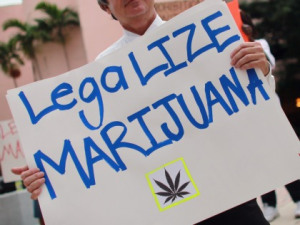Most observers agree: California will legalize, sooner or later. Probably sooner. The question is, how soon?
Several groups are working to put legalization on the ballot in the next two elections, and polls show most Californians would vote yes. They rejected an initiative to make weed legal in 2010, but public opinion has made a dramatic turnaround since then.
 But now there’s a problem. There are four ballot proposals competing for the 2014 election, and a fifth in the early planning stages for 2016. It’s possible one could make it onto the ballot this year, it’s possible none could make it onto the ballot, and it’s possible more than one could make it onto the ballot.
But now there’s a problem. There are four ballot proposals competing for the 2014 election, and a fifth in the early planning stages for 2016. It’s possible one could make it onto the ballot this year, it’s possible none could make it onto the ballot, and it’s possible more than one could make it onto the ballot.
The last outcome is the least likely, since only two of the initiatives have yet been cleared to gather signatures in advance of a February deadline. But if the wrong proposal ends up on the ballot in 2014, voters could likely reject it.
So why aren’t these groups working together to ensure victory in California? It has a lot to do with the way marijuana policy developed in the state over the last two decades.
Voters here adopted medical pot in 1996. But the ballot initiative they passed was vague and broad, and soon unregulated dispensaries began popping up by the hundreds across the state.
This led to conflict within the marijuana community, as some advocates wanted more regulation while others wanted to take advantage of the lax environment and push for quick legalization. The drive to legalize in 2010 united most activists, with the exception of some in the MMJ community, but it failed by 7 percentage points.
That drove a new wedge between the various factions: patients’ rights groups, civil libertarians, cultivators, dispensary owners. Different players had different agendas and different opinions on when the movement should strike again – and how.
The two proposals that are now collecting signatures take a relatively lax approach to regulation. Both allow the state to regulate marijuana for adults in the same manner as alcohol, but they essentially include no limits on personal possession or cultivation.
The Marijuana Control, Legalization and Revenue Act of 2014 would impose no limit on possession, while the California Cannabis Hemp Initiative, also known as the Jack Herer Initiative, would allow people to possess up to 12 pounds of weed and grow up to 99 plants per year. Even heavy medical users would be hard-pressed to consume that volume.
No one knows whether voters would take such a dramatic step. And no one knows exactly how federal authorities would react to a legal weed system with no caps. But they could see it as a boost to interstate trafficking and use that as an excuse to crack down.
The other two proposals for 2014, both awaiting initial approval from the California attorney general, do impose specific restrictions on how much weed adults could possess and grow, though plan one may be more realistic than the other.
The Control, Regulate and Tax Marijuana Act of 2014 sets a limit of one ounce and six plants per adult, along with a number of other tight restrictions. Backed by the powerful Drug Policy Alliance, this initiative may have the most potential, though it’s not yet clear whether the group will make a concerted push to get it on the ballot.
 But this is where the money is now, and there’s no indication it will go to either of the proposals currently circulating petitions. Without big money, they probably won’t reach voters on election day.
But this is where the money is now, and there’s no indication it will go to either of the proposals currently circulating petitions. Without big money, they probably won’t reach voters on election day.
That leaves a fourth proposal, the Cannabis Policy Reform Act, submitted by longtime activist Ed Rosenthal. It allows possession of up to 3 ounces, more than either of the states that have legalized, as well as cultivation of up to 100 square feet outdoors or 2,600 watts of light indoors.
The two initiatives currently gathering petitions don’t appear to have much chance of success. The Drug Policy Alliance and its fellow advocates haven’t yet put their full weight behind their proposal. And the fourth plan, though favored by many in the industry, may not have the necessary backing – and may be too lax for more skeptical voters.
So what happens if a fractured community can’t get the job done this year? There’s always 2016, and a number of heavy hitters, including the state’s lieutenant governor and the ACLU, are waiting in the wings until then.
Why? For one thing, presidential elections bring out many more young voters than midterms, and young voters are more likely to support legalization. Also, enough time will have passed to prove legal pot works in Colorado and Washington.
But some activists fear waiting could backfire. Marijuana reform is sweeping the country, with several states ready to act over the next few years, and California could miss its moment, said Graham Boyd, counsel to the late cannabis financier Peter Lewis.
“The main thing is growing public support,” Boyd said in October. “I think you can look at the list of 2016 states and argue that any of them could go in 2014. If the public is ready in 2014 and something happens before 2016 and that lift tails off, we may find ourselves saying we missed the wave.”
 California Marijuana Market Breaking "Marijuana News" from CA
California Marijuana Market Breaking "Marijuana News" from CA


